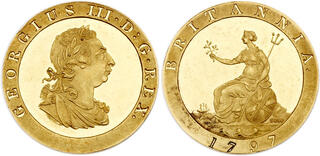| Ira & Larry Goldberg Coins & Collectibles > Auction 137 | Auction date: 29 January 2024 |
| Lot number: 1141 Price realized: 33,000 USD (Approx. 30,565 EUR) Note: Prices do not include buyer's fees. | Show similar lots on CoinArchives Find similar lots in upcoming auctions on |
| Lot description: Great Britain. Pattern Farthing Struck in Gold, 1797. Peck-1191 (EXR). 9.2g. Restrike. George III, 1760-1820. The elderly king is depicted facing to the right, his body draped, his hair laureate. In classic Soho Mint style, the portrait is centered within a recessed circle. On the reverse, Britannia is shown seated facing left, SOHO mint name on a rock behind her, all within a recessed center. Edge is plain. A brilliant example of this great rarity. Pop 1; The only one graded at PCGS. PCGS graded Proof 63 Deep Cameo. Estimated Value $15,000 - UP Beginning in the 1780s, Matthew Boulton and James Watt revolutionized Great Britain's coinage, indeed altered the very nature of its hard money. Boulton owned a button manufactory in Birmingham but he was more than an industrialist; he was a man of vision and an entrepreneur in every fiber of his body. Acutely aware of the depressed state of the coinage that was circulating in the 1780s, he decided to team up with Watt, inventor of the steam engine who held important patents, and the pair commenced upon their greatest of many achievements: establishment of the Soho Mint. Watt modified his invention so as to work in a new way, moving its functional parts up and down, rapidly, as powered by steam. It could pound out buttons (and coins!) faster and better than had ever been possible, with perfect accuracy. Boulton put his entire manufactory at the disposal of their new enterprise. They began with a tentative pattern halfpenny coinage in the late 1780s. It and subsequent, boldly struck coins made on contract so impressed the officers of the king's Royal Mint that Boulton and Watt won important contracts to make a series of entirely new-looking, modernistic copper coins-including the first-ever copper penny, dated 1797. The enthusiastic acceptance of their copper farthings, halfpennies and pennies led to a contract to create temporary money in the late 1790s by over-striking foreign silver coins, and eventually to the creation of the uniquely styled 1804 Bank Dollars. These coins saved an economy that was faltering because of extreme lack of both silver and copper money. Aside from millions of such coins made to enter commerce, the Soho Mint also created some of the finest proof coins for collectors. Dozens of patterns and proofs came from the proofing presses of the Soho Mint, in a variety of metals. After Soho closed its doors in the 1820s, an enterprising dealer in antiques purchased some of Soho's old dies and re-struck pieces for collectors. Mostly these were minted very carefully in the first few decades of the 19th century. Copper, sometimes bronzed, sometimes gilt, was the most used metal for these now-celebrated re-issues. Silver strikes were made only occasionally, thus quite rare. Gold pieces were the rarest, originally intended for the collections of wealthy men, often friends of Boulton who requested specially made coins. The glorious gold farthing seen here is one of those. Ex Spink, London, private treaty, May 2005. |  |


